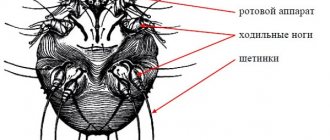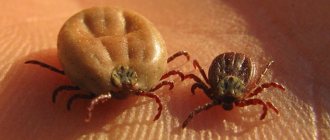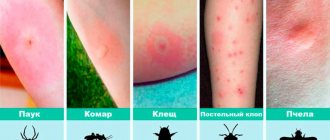The danger of ticks is not that they can suck on and drink blood, but that they are often carriers of infectious diseases. When bitten, along with saliva, harmful viruses and microorganisms enter the animal’s body, multiply and spread along the bloodstream. One of the most common dog diseases that a tick can infect a dog with is piroplasmosis. And it can be fatal. We will tell you by what symptoms you can recognize piroplasmosis, how to help your dog, and what else ticks are dangerous for animals.
How does a dog behave after sucking a tick?
After a parasite bite, the dog’s behavior changes - due to itching, it may be restless and constantly scratch a certain area of the body, or it may become lethargic and refuse to eat. The color of the mucous membranes may change (we are talking about the mouth and eyes, where the mucous membranes turn white or become yellowish), as well as urine and feces (urine darkens and becomes burgundy, feces become greenish).
Sometimes the temperature rises and problems with motor activity appear. If your pet's behavior changes, you should carefully examine its body, parting the fur - if you find signs of a tick, take the dog to the veterinarian.
How to remove a tick from a dog
If your dog lives outdoors and often accompanies you on trips to the river and forest, he may be attacked by several ticks at once. Getting everyone out individually is not an easy task. For this case, pet stores offer special shampoos: they help destroy those who have attached themselves, as well as mite larvae.
If you go this route, don’t forget to change your dog’s “bedding” often, or at least shake it out thoroughly, because larvae can remain on the bedding.
When your dog is attacked by single representatives of harmful arthropods, do not be lazy to examine your pet after each walk. Be sure to check the armpits on the front legs, the groin area, the stomach and, of course, the ears.
How to remove a tick from a dog? Most often this is done with vegetable or machine oil, Vaseline and even nail polish. You need to drop one of these substances onto the tick and wait a few minutes until the tick loosens its grip (if you are lucky, it may even fall off without your participation). After that, try to remove it.
This should be done with gloves (so as not to get infected yourself), armed with tweezers - carefully, as if twisting. Direction is counterclockwise. How to remove a tick from a dog using a thread? First of all, make sure that the thread is strong and will not let you down at the most crucial moment. Then tie it close to the proboscis. Pull the ends of the thread in both directions, simultaneously pulling the insect up.
It is important to remove the tick completely, since if its proboscis or head remains in the wound, the problem will not be solved, and the risk of infection will still remain relevant.
If the head does come off and remains in the wound, it looks like a black dot. Remember how you had to remove a splinter from your finger and do the same thing, using a regular needle.
The “operation” is completed by wiping the wound with iodine or brilliant green.
By the way, scientific and technological progress does not stand still: original devices have appeared in pharmacies, with their help you will be able to help your pet faster and better than using tweezers and thread.
Suction places
Parasites love areas with delicate, soft skin, where it is easy to attach themselves. Most often they choose places in the ears, on the neck, at the withers, on the stomach and near the limbs. But these are only the most “tasty” areas; in fact, the parasite can attach itself anywhere, so inspect the dog after a walk in its entirety. When a tick lands on the body of a potential host, it does not immediately attach itself - first the arthropod crawls, picking up the most “tasty” area. That is, during a long walk, it makes sense to examine the dog at intervals of 30–60 minutes - perhaps you will be able to prevent the tick from sticking and remove the parasite in time.
Prevention
Unfortunately, today there is no 100% effective means of protection against piroplasmosis. And this is not surprising, because Babesia is not a virus, but a parasite. Therefore, the most effective prevention of piroplasmosis was and remains the protection and prevention of infection of your beloved pet from ticks.
But here the pet market offers many different products: collars, sprays, drops, tablets. We will not describe each of them in detail. Read about modern flea and tick treatments for dogs. There we talk in detail about the most popular ones.
A few years ago, to the delight of dog breeders, a vaccine was invented. But, unfortunately, it also does not provide a 100% guarantee against infection. The vaccine can only neutralize the toxic substances released by Babesia and, thereby, promote a speedy recovery of the pet after treatment. The effect of the vaccine is not so durable - only 6 months. But in the case of a tick bite, death is almost completely excluded. Today, according to veterinarians, the most effective are two vaccines: Pirodog and Nobivac Piro.
Whatever preventive methods you use to protect your beloved pet from piroplasmosis, it is important to examine the dog after every walk.
Symptoms and signs of suction
When a tick attaches itself to a dog, it continues to feed on its blood for several more days. In some cases, parasites remain on the host for up to two weeks. Gradually increasing in size, the tick becomes noticeable - the back part of its body stands out, which is easy to see - you just need to move the dog's fur apart. If the tick has already fallen off, after the bite, a red spot with a drop of dried blood in the center or a wound remains on the dog’s body.
Soon after a tick bites, your dog will experience the following symptoms:
- itching (appears within a few hours after sucking an arthropod);
- at the site of suction - a hyperemic area of skin;
- When a tick is parasitized for a long time, swelling and inflammation appear at the point of suction.
Ticks are small - depending on the type, their size can be in the range of 2.5–30 mm. But the tick begins to drink blood, increases in size (sometimes several times) and becomes more noticeable. If you examine the dog after every walk, it is quite possible to notice the attached parasite and provide timely assistance to the pet.
The causative agents of piroplasmosis are protozoan blood parasites of the genus Babesia. Babesia multiplies in red blood cells (erythrocytes), leading to serious health problems, including death. The incubation period is from 2 days to 3 weeks.
If it happens that a tick has infected a dog, the following symptoms may appear:
- An increase in body temperature is the first sign of the disease.
- Darkening of urine. The urine darkens and blood appears in it.
- Increased breathing, the dog quickly gets tired, becomes lethargic, apathetic, refuses walks, and loses appetite.
- Diarrhea and vomiting are the result of general poisoning of the body. Vomiting leads to dehydration, which further weakens the dog's body.
These symptoms last 2-3 days. If you do not seek treatment from a veterinarian at this point, your pet’s condition will worsen significantly. At the same time, the disease progresses, and new symptoms appear:
- Redness, yellowing or blue discoloration of the mucous membranes of the mouth and eyes, which is caused by impaired liver function and oxygen deficiency.
- The heartbeat is rapid and very weak, as the load on the heart increases greatly.
- The appearance of shortness of breath and difficulty breathing.
- Complete refusal of food, lack of physical activity, weakening of the hind limbs - all this is caused by the active destruction of the dog’s body.
- Partial or complete paralysis of the limbs, which is accompanied by convulsions.
Diseases of dogs from ticks
The easiest way to cure a dog is from small parasites called ear mites. They cause otodectosis, a disease that develops only in four-legged animals, popularly called ear scabies. In advanced cases, especially if an ear mite is found on a puppy, it can spread throughout the animal’s entire body. In this case, the canine ixodid tick causes not only discomfort, but also very unpleasant sensations.
What are the symptoms of a tick bite in dogs in this case? The dog begins to itch, and yellow or brown liquid comes out of the ears, and the dog often shakes its head. How to treat a dog for mites called ear mites? In this case, it is enough to use special drops in the ears “Bars” and liquid on the withers.
Where can I get something to treat my dog against ticks? These drugs are available and can be found at places of sale of pet products.
It is more difficult if your pet is bitten by an ordinary tick. It can carry:
- encephalitis;
- piroplasmosis:
- Lyme disease (in rare cases, so we won't cover it).
Diseases caused by tick bites in dogs without modern therapy are fatal. If you notice signs of a tick bite in your dog, you should monitor its condition. Symptoms of encephalitis in dogs develop after 14 days. These include:
- high temperature;
- convulsions;
- motor impairment;
- pain in the neck and head;
- paralysis.
If your pet's temperature rises after a tick bite, you should immediately take him to a veterinary clinic for a blood test. This reaction occurs in almost all dog diseases caused by a tick bite.
Treatment of encephalitis in dogs is quite complex. In each specific case, different drugs are administered.
If a dog is bitten by a tick, treatment at home is impossible. At a minimum, you need to take a blood test. If you find signs of a dog being bitten by an encephalitis tick, then you need to get to the clinic literally in the next few hours; the sooner you show your pet to the veterinarian, the greater the chance that the outcome of the disease will be successful.
To recognize piroplasmosis in dogs, a photo will not help you. In this case, the symptoms of dog illness from a tick bite will be as follows:
- a sharp increase in temperature, and then its decrease to normal;
- body trembling;
- dyspnea;
- pallor of the mucous membranes;
- vomiting and diarrhea;
- staining of urine in a darker color, there may be traces of blood in it;
- hind limb problems;
- refusal of water and food.
Ticks cause different diseases in dogs, but their symptoms are similar, so the first thing you should do is conduct a laboratory blood test.
There is little you can do on your own, pending the results of the analysis. First of all, do not allow dehydration - pour up to 150 ml of clean water into the dog, and if vomiting, inject the liquid rectally or under the skin.
It will be impossible to completely cope with the disease without administering the right medicine. Try to have anti-parasite drugs “Veriben” or “Azidin” in your first aid kit, if you are traveling far from veterinary clinics, then the question of how to treat a dog bite will not arise.
They are administered at the rate of 1 ml per 20 kilograms of weight. If the puppy is bitten by a tick, then 0.5 to 1 ml of medicine will be enough. As an auxiliary therapy, the pet is administered glucose, vitamins B12 and B6 three times a day.
What to do if your puppy is bitten by a tick? The treatment process in this case is not at all different from what needs to be done for an adult animal. However, remember that after a puppy has been bitten by a tick, an analysis must be done. Antiparasitic medications are very toxic and can harm a fragile organism.
What to feed a dog with piroplasmosis? Anti-parasite medications and the disease itself have a depressing effect on the pet’s gastrointestinal tract, so you should not feed the dog, even if it persistently asks for food. A dog injection from ticks that carry piroplasmosis is very toxic, so it is important for your pet to take a course of vitamins.
Removing ticks at home
The longer a tick is on a dog, the greater the dose of infection it can transmit to it. Therefore, you need to remove the parasite as soon as possible, but do it correctly.
The most effective and safe way to do this is with the help of the Mite Card. Place its groove under the body of the parasite and effortlessly move the Tick Card forward. Remove the parasite from your pet and, without touching the tick, place it in the test tube from the Tick Card kit. Treat the bite site with an antiseptic wipe. That's it, now there is no need to panic - even if the tick was infected, its effect on the dog has ceased. Call your veterinarian and follow his instructions. The animal will need to be monitored for 2-3 weeks so as not to miss alarming symptoms. Usually, if no signs of illness appear, it is assumed that the dog is not infected.
What is piroplasmosis (babesiosis)?
The causative agents of piroplasmosis are single-celled piroplasma parasites (Piroplasma canis or Babesia canis), which enter the body through a tick bite. The parasite is transmitted by ixodid ticks of the genera Dermacentor and Rhipicephalus. In the international classification, the disease is called babesiosis.
Pyroplasmas are found in the salivary glands of the tick and when bitten, along with saliva, enter the blood of dogs. In this case, the destruction of red blood cells occurs, a large volume of hemoglobin is released, this leads to the fact that the internal organs of the animal cannot cope with such a load.
The consequences of all this are the release of toxic substances (decomposition products), as a result of which organs such as the spleen, liver, and kidneys suffer. The most serious consequence is hypoxia of the animal’s brain (oxygen starvation).
Mite of the genus Dermacentor
Tick of the genus Rhipicephalus
Although babesiosis has been well studied and highly effective treatments are available, it is often fatal, usually because the animal is brought to the veterinarian too late.
The longer piroplasmosis lasts, the more severe the consequences for the body.
The disease has a pronounced seasonal peak character: the warm season (spring-summer). Peaks of incidence occur in May-June and August-September. However, the disease can occur from April to the end of October.
Typically, ticks attack dogs while walking in areas overgrown with bushes or tall grass.
Newly attached, it is no larger than the head of a pin; Once pumped with blood, it can reach the size of a large bean.
Where do ticks come from on dogs?
What other diseases are transmitted to dogs from different types of ticks?
Tick sucking does not guarantee a dog's illness. But, if the parasite managed to attach itself and the infection entered the dog’s body, it is important to react in time and provide the dog with quality treatment.
| Disease | Pathogen | Symptoms |
| Encephalitis | Tick-borne encephalitis virus. Its danger is that it affects the brain and spinal cord. This can lead to serious consequences and death. The incubation period can last several weeks, so after the parasite has been sucked on, you need to monitor your pet and monitor its condition. |
|
| Hepatozoonosis | Parasites H. americanum and Hepatozoon canis (they infect blood leukocytes). The peculiarity of this disease is that symptoms are absent for a long period, but appear with a subsequent decrease in immunity. A dog becomes infected with hepatozoonosis when, trying to gnaw a tick from its skin, it swallows it. |
|
| Bartonellosis | Bacteria of the genus Bartonella, which infect red blood cells and endothelial cells. Bartonella often attacks the mucous membranes of the gastrointestinal tract (they love the oral cavity of dogs), eye tissue, mucous membranes of the respiratory tract, liver and lymph nodes. |
|
Types of ticks
Ticks that parasitize dogs are divided into 2 groups:
- External
- Subcutaneous
Next we will take a closer look at each of these types.
External
In turn, external mites are divided into groups:
Ear mites
Mites in the ear
This mite causes ear scabies, a very common and contagious disease in animals. They are localized mainly on the inside of the ear, less often they migrate to the animal’s head. Ear mites live for two months, outside the animal’s body for up to two weeks.
Ixodid ticks
What does an ixodid tick look like?
Tick fed on blood
They are forest ones. This is the most common species (we will talk about them in more detail) that lives in forests, parks, trees and bushes. Such ticks are dangerous because the animal does not feel the bite due to the secretion secreted by the tick. If the tick is infected, then transmission of the disease is inevitable.
Heyletiella
Cheyletiellosis in a dog
The causative agents are ticks of the species Cheyletiella yasguri, oval in shape and about 0.38 mm in size. They cause diseases such as: cheyletiosis (Cheyletiosis, Cheyletiellosis, Cheiletiosis) or “stray dandruff”. A person who comes into contact with an infected animal can also become infected, since these diseases are transmitted by contact. Localization of parasites occurs in the upper layer of the skin.
The main symptom is severe flaking of the skin, similar to dandruff. This disease occurs in all breeds of dogs and looks like moving pieces of skin.
Argasid mites
Argas mite
Such ticks attack in large groups and cause exhaustion in animals. They are similar to ixodid ticks, but live in drier and hotter places, as well as in enclosed spaces. The bites are very painful; infection occurs not only through the bite, but also through the secretions of these ticks. They are carriers of borreliosis and encephalitis. Without a host, argas mites can live up to 14 years.
Subcutaneous mites
Subcutaneous mites are further divided into several types:
Sarcoptoides
Sarcoptic mange
Itching mites of the genus Sarcoptes, which cause sarcoptic mange and feed on lymph and dead skin particles. They settle on the muzzle, head, tips of the ears and in the elbow bends. Infection occurs through contact or through care items.
Symptoms: itching, the dog is very itchy, small spots on the body, pus and ulcers may appear.
Demodectic
Dog with subcutaneous mites (Demodectic mange)
Or "hairy". The causative agent is the Demodex mite. They live in hair follicles throughout the dog's life. According to veterinarians, the presence of demodicosis is normal for domestic dogs.
Scabies (Notoedrosis)
Notoedrosis
The culprits are scabies mites of the genus Notoedris cati. They multiply inside the epidermis and cause a disease - notoedrosis, accompanied by skin inflammation and severe itching. At the beginning of the disease, they settle on the animal’s head, then spread to other parts of the body. Possible death if the disease is neglected.
Symptoms: blisters (papules) that become crusty, bald spots due to scratching.
Diseases caused by ixodid ticks
Let's take a closer look at the diseases that occur after an ixodid tick bite:
- Hepatozoonosis. With this disease, leukocytes are damaged, fever begins, joint pain appears, the eyes become inflamed, and weakness is observed.
- Ehrlichiosis. The disease develops in white blood cells and is accompanied by debilitating fever.
- Borreliosis. Develops inside the womb and leads to the death of the offspring. Arthritis and neurological abnormalities are observed.
- Piroplasmosis. The most common disease in dogs after a tick bite in the Russian Federation. We will talk about it in more detail.
Recommendations for protecting your pet
To prevent infection, it is recommended to treat the dog with anti-tick medications in a timely manner or to put on a special collar (overalls). But in practice this is not as easy as it seems - sometimes owners in a hurry forget about treatment, sometimes the anti-tick agent is ineffective. Some dogs are at risk around the clock - for example, if they live on the street, in the courtyard of a private house.
Vaccination is not a guarantee of protection against ticks! Experts emphasize that vaccination does not protect against bites and infection; it only alleviates the course of the disease and reduces the risk of complications. Of course, there are cases when vaccinated dogs do not get sick, but we cannot talk about 100% protection against infectious diseases.
To protect your dog, choose the safest places to walk, use anti-tick medications, and inspect your pet’s body after walking. Inspect not only the “tasty” places for ticks (belly, withers, ears), but also the entire surface of the body, spreading the fur.
Mite Card is ideal for this purpose ; it allows you to remove the parasite whole and alive, without spoiling the fur or torturing the pet. After removing the tick, treat the suction site with an antiseptic. Consult your veterinarian for recommendations - you will need to monitor the dog throughout the incubation period. To find out what the likelihood of infection is, the tick can be tested - put it in a test tube (without touching it with your hands) and take it to the laboratory.
Prevention. drugs and protective equipment
Drops on the withers
Prevention of piroplasmosis consists in preventing an attack on the animal; for this, they are treated with acaricidal drugs, which are available in the form of:
| Flea and tick remedies. Prices. | ||
| Collars | “Foresto”, “Kiltix”, “Bolfo”, “Hartz”, “Beaphar”. | The cost of collars is from 200 RUB to 2000 RUB. Depending on the size of the dog and the function of the collar |
| Sprays | “Frontline”, “Bolfo”, “Defendog”, “Bars”. | Spray prices from 250 RUB to 1500 RUB |
| Drops on the withers | "Advantix", "Frontline", "Hartz", "Bars", "Serco", "Stronghold". | The price of drops is from 120 RUB to 1500 RUB. Depending on manufacturer and volume |
| Pills | "Bravetko", "Frontline", "Zoetis", "Nexgard Spectra" | The cost of tablets is from 400 RUB to 2000 RUB |
These products are distributed over the skin and hair without being absorbed into the blood. Upon contact with treated hair and skin, it dies. These products, unfortunately, do not provide 100% protection against parasites; the effectiveness of these drugs depends on how much time has passed since their application. Protective equipment must be used in advance (2-3 days before going out into nature or going on vacation).
When purchasing protective equipment in veterinary pharmacies or pet stores, be sure to pay attention to the expiration date, integrity of the packaging, and instructions in Russian. Be sure to read the instructions!
It must be remembered that:
- When using anti-mite drugs, contact allergies are possible.
- When using the spray, it is necessary to treat not only the animal’s body, but also the paws and head, and especially carefully the groin area, armpits and behind the ears.
- If the dog has long hair, then the spray consumption increases up to 2 times.
- If your dog bathes frequently (or you wash it), then the frequency of anti-tick treatments needs to be increased.
- The packing of drops at the withers must strictly correspond to the weight of your pet.
Very often, owners turn to the veterinary clinic with a request to get vaccinated against piroplasmosis. Currently, in order to form an immune response in dogs to the causative agent of babesiosis, the Pirodog Vaccine is used.
Vaccine Pirodog
Folk remedies for ticks
How else can you protect your dog from ticks?
Below are traditional methods for fighting ticks for animals:
- Vanilla tincture. Mix 100 ml of vodka with 7 g of vanilla and leave for 7 days. Apply to the withers, belly and llamas immediately before a walk.
- Fragrant (scented) collar. 15-20 essential oil, which is effective against ticks, is applied to the animal’s collar. Used exclusively for walking.
- "Perfume" with the aroma of wormwood. In this recipe you can use dry wormwood (20 g) or fresh (50 g). Mix the wormwood with 400 ml of water and boil. Cool and pour into a spray bottle. We use such perfumes when necessary. When walking for a long time, apply perfume every 2-3 hours.
IMPORTANT! Monitor the animal's reaction to a particular essential oil.
Even though you take precautions, keep a close eye on your dog and check it regularly. If signs of illness occur, contact your veterinarian.
Remember, self-medication can cause irreparable harm to the health and life of your pet!
If you find similar symptoms in your dog, do not experiment! It is necessary to urgently contact a veterinary clinic; if for some reason this is not possible, use the service of calling a veterinarian at home.
Have you ever encountered ticks? Leave your questions for the veterinarian in the comments.
Which ticks are white?
More than 50 thousand arachnid insects are known to science, of which a good third are mites, but none of them, under natural conditions, are white in color. Visually, mites may appear white due to the coating or the state they are in at the moment. So, which ticks are white?
Turn white when they drink blood:
Important! All four species listed above are relatives belonging to the species of grassland or ixodid ticks.
Scabies, dust and spider mites have a white coating, but they are microscopic. Flour mites have a white edge but are not parasitic on dogs. Ear mites are almost white in color. However, in fact, these parasites have an almost transparent shell.
Which white tick is dangerous to humans?
A tick that is dangerous to humans, which can have a white color, is a macro tick, the most famous and widespread is the ixodid tick.
There are the following types:
- European or forest;
- taiga;
- village, meadow.
The ixodid tick is quite large - after biting and sucking blood it can reach 1 cm. If you find a tick on your body that looks like it has a white bottom - this is not a separate subspecies, this color is typical for most female ticks; when filled with blood, the tick's body stretches and thus its shade becomes less saturated and brightens.
It is also worth remembering that the ixodid tick is a family of ticks that has hundreds of species. So, of course, they can be of different colors and shades, including light ones: beige, grayish, pink, or have a white pattern on the back (meadow tick).
The essence of the problem of a tick bite does not change from their appearance; any ixodid ticks can be carriers of diseases - encephalitis, anaplasmosis, borreliosis, tick-borne typhus, various types of fevers, in general, all those for which it is worth thoroughly studying the possibilities of avoiding tick bites and rules of conduct after a bite.
Perhaps the main problem with a white tick is that it is much harder to notice it on the skin than a dark one, especially if it is a small individual. People often mistake such a tick for a wen or some kind of small wound.
Be careful, especially if you live or visit areas where tick-borne encephalitis is endemic, be sure to inspect your skin after hiking and walking in nature. Take a close look at the photo of the white ixodid tick to identify and neutralize the parasite in time.
Another common type of ectoparasite (external) is ticks in dogs. When people talk about ticks and how dangerous it is in the warm season, they mean one of the types of skin parasites – ixodid ticks (Ixodidae). In fact, several species of these arthropods parasitize dogs. Some of them gnaw the skin of animals, others suck blood, and for others, the lymph and skin secretions of your pet are a source of food. As a result of the activity of ticks, the animal may develop a severe allergic reaction, viral and bacterial diseases, as well as abscesses and dermatitis.











